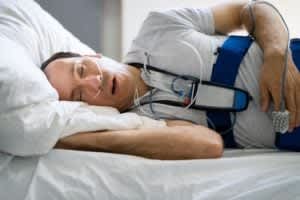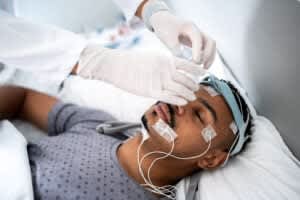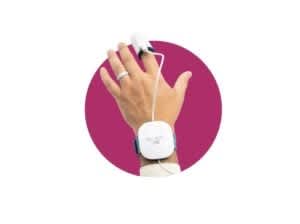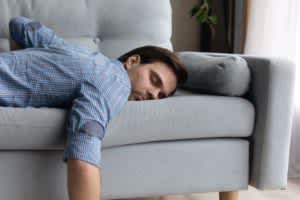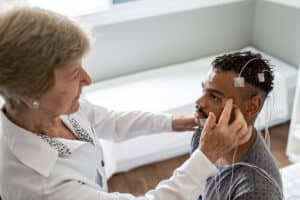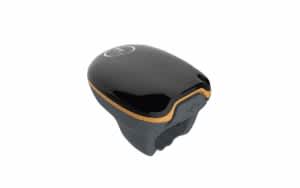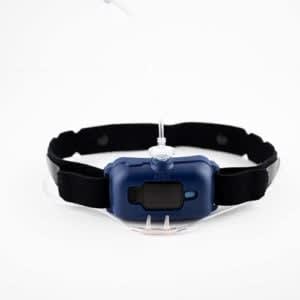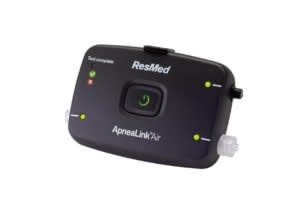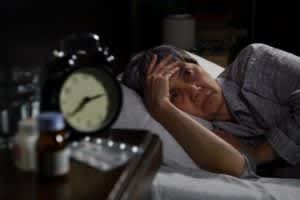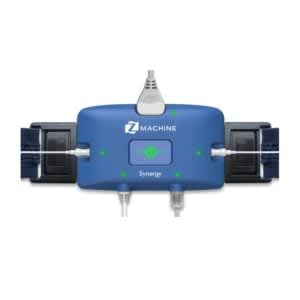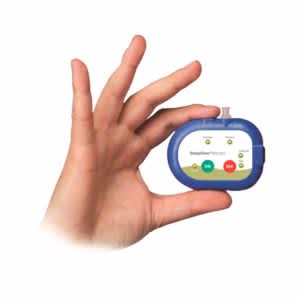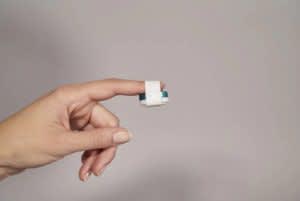Price:
$295When you buy through our links, we may earn a commission. Products or services may be offered by an affiliated entity. Learn more.
Philips Alice NightOne Review
The content on this page should not be taken as medical advice, nor do we claim this test reflects diagnosis. Always consult your doctor in regards to using this device and any test results it may indicate.

Philips Alice NightOne

Sleep Foundation Special Offer
Use this SleepFoundation.org link for the most current discount on Philips products
The Philips Alice NightOne is a wearable device designed to detect sleep apnea. Using three sensors, the at-home testing device tracks seven bodily metrics that collectively can allow your doctor to determine if you have sleep apnea, a condition characterized by pauses in breathing during sleep.
Customers typically get a four-night device rental as well as sleep study results that are reviewed by a doctor.
We’ll cover how the device works, what types of medical data it records, and how that information relates to sleep apnea. We’ll also discuss who is a good fit for the Alice NightOne and who should stick to a traditional overnight sleep study in a lab setting.
What Is Obstructive Sleep Apnea (OSA)?
Obstructive sleep apnea (OSA) is a condition that causes a person to gasp or choke in their sleep because of a blockage in their breathing passage. This restriction typically occurs when the muscles surrounding the throat relax and collapse, narrowing the upper airway. In the U.S., OSA affects an estimated 10% to 30% of adults.
The apnea-hypopnea index (AHI) is a diagnostic tool that measures OSA severity. An apnea is when breathing ceases, while hypopnea is a term for shallow breathing. AHI score is calculated by dividing the total number of apneas and hypopneas a person experiences during sleep by the total number of hours they were asleep.
| Sleep Apnea Severity | AHI Score |
|---|---|
| Mild OSA | 5-15 |
| Moderate OSA | 15-30 |
| Severe OSA | 30 or higher |
Common OSA symptoms include loud snoring, waking up unrested, dry mouth, and headaches. If you’re constantly tired, have routine morning headaches, or have been told by a sleep partner that you’re not breathing correctly while sleeping, you may want to consider getting tested for OSA.
Men or people assigned male at birth, those with a high body mass index (BMI), and people with large necks or tonsils may have an increased chance of developing OSA. When untreated, sleep apnea can cause a number of health problems, including cardiovascular diseases, high blood pressure, and depression.
The Philips Alice NightOne is also designed to detect central sleep apnea (CSA). This less prevalent sleep breathing disorder has symptoms similar to OSA but is caused by the brain briefly failing to send signals to the muscles that control breathing.
How Does the Philips Alice NightOne Work?
The Philips Alice NightOne has three sensors that monitor seven data points to help detect sleep apnea. A nasal cannula, pulse oximeter, and effort belt that houses the main Alice NightOne unit measure the following metrics:
- Body positioning: A sensor in the Alice NightOne device detects your body position and how it changes throughout the night. It also measures any breathing changes that occur when you sleep in different positions.
- Pressure flow: The nasal cannula monitors your breathing and measures air pressure. It tracks both inhalation and exhalation to give a clear picture of how many apneas and hypopneas occur while you sleep.
- Amount of snoring: The cannula also detects snoring frequency, which can be an important indicator of OSA.
- Respiratory effort: The effort belt measures how long you go between breaths and how physically challenging it is for you to breathe.
- Blood oxygen level (SpO2): The pulse oximeter on your finger tracks your blood oxygen level. Apneas and hypopneas may decrease your oxygen saturation, which can be harmful to your health.
- Pleth: The pulse oximeter also detects any fluctuations in your blood flow.
- Heart rate: The Alice NightOne measures your pulse throughout the night. Your physician can use this information in conjunction with your breathing patterns to better understand how difficult it is for your body to breathe during sleep.
Each of these metrics offer useful information for detecting sleep apnea. When combined, the seven data points provide a more complete picture of your sleep health. Failing to fit and wear each device component properly may result in incomplete or incorrect data.
While your doctor may recommend the Alice NightOne as a sleep apnea testing option. The following is an example of a procedure when buying from an online retailer. The testing process may differ slightly depending on where you purchase from.
- Step 1: Before purchasing the device, you’ll need to complete a brief online questionnaire. The testing kit usually isn’t available for purchase in Delaware, Hawaii, North Dakota, or Rhode Island.
- Step 2: Your kit should arrive in two to three business days. Open the package, read the directions thoroughly, and place the pulse oximeter, nasal cannula, and effort belt on your body as directed just prior to your normal bedtime. The device automatically turns on when the effort belt is buckled.
- Step 3: Go to sleep, then check the device in the morning to ensure it captured high-quality data. The Good Study Indicator lights will show green or yellow to report information quality. If the device indicates that it failed to capture complete data, contact the company to troubleshoot the issue. If you need to redo the test, the company will mail you a new kit for just the cost of shipping and handling.
- Step 4: Carefully remove the sensors. The nasal cannula can be discarded. The other device components should be placed in the included return packaging and promptly mailed back.
- Step 5: Once they receive the kit back, test results are typically available within two to four business days. The results will be sent via secure email. If you’ve completed a medical release form, the results will also be shared with your doctor.
- Step 6: If the test results indicate you have sleep apnea, the next step is to review the results with a physician. You can also schedule a telemedicine video appointment with a doctor. Depending on your diagnosis, they may recommend a form of positive airway pressure (PAP) therapy.
People with sleep apnea are often prescribed CPAP or APAP machines, which either deliver continuous pressurized airflow through a hose and mask or automatically adjust air pressure based on algorithms that detect breathing patterns.
How Do You Set Up and Use the Philips Alice NightOne?
The Alice NightOne has three wearable components: an effort belt, a nasal cannula, and a pulse oximeter. A small device connects to the effort belt to track and store your sleep data. It also has sensors that light up green to indicate that the components fit well, or yellow to alert you of an improper fit.
Setting up the Alice NightOne involves several steps:
- Wrap the effort belt around your upper chest and click the connecting ends together. People with breasts should place the belt above them, while those without can situate the belt a few inches lower.
- Use the adjustment tabs to loosen or tighten the belt as necessary. It should fit snugly to the body. Philips recommends wearing a loose-fitting shirt beneath the belt. The device powers on automatically once you connect the belt ends.
- Connect the cannula tube to the device on the effort belt. Then, place the nasal cannula prongs carefully into your nostrils, taking care to ensure the angle is correct. Loop the cannula tube behind each ear and under your chin. Move the chin slider to a comfortable spot and tape the cannula tube to your cheeks.
- Attach the pulse oximeter cord to the device and place the finger sensor over the index finger of your non-dominant hand. Tape the cord to the back of your hand to keep the sensor in place.
- Each time you attach a component to the device, the corresponding sensor will flash yellow until you take a few breaths, then it will turn green. If any of the sensors stay yellow, adjust the component’s fit until the light turns green. The sensors will stay solid green before shutting off one at a time. Once all the green lights have turned off, the device is ready and you can go to sleep.
Keep the Alice NightOne on at all times, even if you get up during the night. In the morning, end the study by pushing the large round button on the device’s front until the sensors flash. Wait one minute, then press the button again to check the Good Study Indicator. If the whole indicator is green, your test was successful. If there are any yellow segments, contact the company to troubleshoot the issue.
Who Should Use the Philips Alice NightOne?
The Philips Alice NightOne is a good option for people who suspect they may have sleep apnea but don’t want to participate in a lab-based sleep study. While overnight polysomnography at a sleep clinic remains the benchmark for accurately diagnosing sleep apnea, it can be expensive and inconvenient, and some people have difficulty sleeping in a clinical setting.
The Alice NightOne is approved by the Department of Transportation for use by commercial truck drivers who meet certain diagnostic criteria and are required to test for sleep apnea as part of their physical exam. However, it is not approved by the Federal Aviation Administration (FAA) as a sleep apnea testing device for pilots.
Pros and Cons of the Philips Alice NightOne
The Philips Alice NightOne offers several benefits for people seeking a convenient at-home sleep apnea test.
- Affordable: This device costs significantly less than a typical overnight sleep study, and the kit includes test results that have been reviewed by a board-certified sleep doctor.
- Minimally invasive: There are only three components you need to wear during the study: a nasal cannula, a pulse oximeter over your finger, and an effort belt around your chest. The sensor lights alert you if a component isn’t fit or connected correctly, and the Good Study Indicator lets you know if enough data was collected.
- Fast turnaround: Devices typically ship within two to three business days. You’ll generally receive your results about two to four business days after the test is returned.
Though the Alice NightOne is more convenient than a traditional sleep study, it has certain limitations and isn’t a great fit for every scenario.
- Limited rental period: Your sleep study payment comes with a four-day rental period for the device. Though you should only need to use the Alice NightOne one time to get a diagnosis, you can’t keep the device for future use and must mail it back promptly to avoid additional credit card charges.
- Less comprehensive results: This is a type 3 sleep monitoring device that doesn’t provide the more detailed information of type 1 and 2 tests. At-home sleep apnea tests are also less precise than an overnight exam at a sleep clinic, increasing the possibility of a false negative result.
- May require further testing: Depending on the results of your test, your doctor may prescribe an automatic positive airway pressure (APAP) machine. This type of device automatically adjusts air pressure when it detects apnea events and generally doesn’t require an in-lab titration study. However, people with more complex forms of sleep apnea may need to visit a sleep lab before they can be prescribed a PAP device.
Cost, Shipping, and Returns
The Alice NightOne is an affordable at-home sleep test. The company does not accept private insurance, though you can pay for the study with a health savings account or flexible spending account or get reimbursed by your insurance company if it covers the test. Online retailers are considered out-of-network for Medicare coverage, so you’ll have to submit a claim to get reimbursement or to count the test toward your deductible.
Your kit includes free shipping as well as paid packaging for returning the device. There is no prescription required, but customers in Guam must get a referral from their doctor.
After ordering your sleep study, you’ll typically receive the device in two to three business days. Upon completing your study, mail the device back in the prepaid packaging. Your result will be emailed to you within two to four days of receiving the device.
The Bottom Line
If you’re looking for an easy way to find out if you have sleep apnea, the Philips Alice NightOne is a great choice. Its user-friendly interface makes it easy to know if the device collected quality data, and it alerts you if it didn’t. It can’t detect disorders other than sleep apnea, but it’s a quick, affordable, and convenient way to get your AHI score and discover measurable data regarding your sleep health.
Purchasing the sleep study kit gets you a four-night rental of the Alice NightOne and a report that’s reviewed by a board-certified sleep doctor. If you need treatment for sleep apnea, you’ll have to follow up with your physician or with a doctor on a telehealth video call. They can go over your options and discuss the benefits of CPAP and other forms of sleep apnea therapy.

Still have questions?
Our product experts have extensive experience testing just about every sleep product on the market. Send an email to [email protected] or call us at (877) 672-8966 with your questions and we’ll help you find exactly what you’re looking for.

